Research News
-
 09 25, 202010 kW Alkaline Zinc-Iron Flow Battery Demonstration System Put into OperationScientists from DIPC a 10 kW alkaline zinc-iron flow battery system. And it was installed and operated in the plant of Baodi Goldsun Co., Ltd in Shandong Yantai, China.
09 25, 202010 kW Alkaline Zinc-Iron Flow Battery Demonstration System Put into OperationScientists from DIPC a 10 kW alkaline zinc-iron flow battery system. And it was installed and operated in the plant of Baodi Goldsun Co., Ltd in Shandong Yantai, China.
Alkaline zinc-iron flow battery has drawn attention due to its features of high open-cell voltage, low cost, and environmental friendliness.
Recently, a research group led by Prof. LI Xianfeng from the Dalian Institute of Chemical Physics of the Chinese Academy of Sciences (CAS) developed a 10 kW alkaline zinc-iron flow battery system. And it was installed and operated in the plant of Baodi Goldsun Co., Ltd in Yantai, Shandong province, China.
The system was made up of electrolyte part, independent kilowatt class cell stacks and the corresponding control system.
Coupled with 13 kW photovoltaic cell, the demo could realize the functions of peak load leveling integration and optimization of renewables, uninterrupted power supply for important loads, etc. via the combination of on-grid and off-grid mode. The system could afford an energy efficiency of 78.7% at constant power of 10 kW.
The demonstration of alkaline zinc-iron flow battery will lay a solid foundation for further development and industrial implementation of this technology.
The 10 kW alkaline zinc-Iron flow battery system (Image by YUAN zhizhang)
The project was supported by CAS STS Program, CAS Engineering Laboratory for Electrochemical Energy Storage, and Major Scientific and Technological Innovation Project of Shandong. (Text by YUAN Zhizhang) -
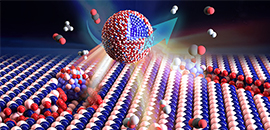 09 25, 2020Researchers Discover Strong Metal-support Interaction Effect between Metal and Inert Boron Nitride SheetsScientists from DICP reported the SMSI effect in transition metal catalysts supported on hexagonal boron nitride (h-BN) sheets.
09 25, 2020Researchers Discover Strong Metal-support Interaction Effect between Metal and Inert Boron Nitride SheetsScientists from DICP reported the SMSI effect in transition metal catalysts supported on hexagonal boron nitride (h-BN) sheets.
Strong metal-support interaction (SMSI) effect is one of the most important concepts in heterogeneous catalysis. This effect is almost exclusively observed in metal catalysts supported on active and reducible oxides, in which the support-derived material can encapsulate metal nanoparticles under certain treatment or reaction conditions.
A research team led by Prof. FU Qiang and Prof. BAO Xinhe from the Dalian Institute of Chemical Physics of the Chinese Academy of Sciences (CAS) reported the SMSI effect in transition metal catalysts supported on hexagonal boron nitride (h-BN) sheets.
The results were published in J. Am. Chem. Soc. on September 14.
Formation of etching nanopits in h-BN sheets aided by Ni particles and encapsulation of the Ni particles by BOx overlayers during dry reforming of methane reaction.(Image by DONG Jinhu)
The scientists observed classical SMSI process between metal nanoparticles, e.g., Ni, Fe, Co, and Ru, and inert hexagonal boron nitride (h-BN) nanosheets.
Weak oxidizing gases such as CO2 and H2O induced the encapsulation of Ni nanoparticles by ultrathin boron oxide (BOx) overlayers derived from the h-BN support during the dry reforming of methane (DRM) reaction.
Experimental and theory calculation results showed that the etched nanopits at the Ni/h-BN interface could confine the Ni nanoparticles against sintering. The amorphous BOx encapsulation overlayers were permeable for the reactants and work synergistically with Ni. Both factors promote the DRM reaction.
This work was supported by the National Natural Science Foundation of China, the Strategic Priority Research Program (B) of the Chinese Academy of Sciences, and the Ministry of Science and Technology of China. (Text by DONG Jinhu) -
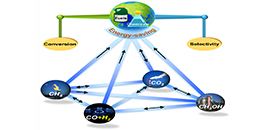 09 25, 2020Catalysis for One-carbon Molecules Conversion Is Promising in Chemical Industry
09 25, 2020Catalysis for One-carbon Molecules Conversion Is Promising in Chemical Industry
Catalytic conversion of one-carbon (C1) molecules, such as methane, carbon monoxide, carbon dioxide and methanol, into fuels and value-added chemicals is an important process in chemical industry.
The most current C1 conversion processes in industry suffer from high energy consumption, complex processes of multi-step reactions, and product separations. Developing C1 molecules oriented conversion technology under mild conditions remains challenging.
Recently, a research group led by Prof. DENG Dehui and Prof. BAO Xinhe from the Dalian Institute of Chemical Physics (DICP) of the Chinese Academy of Sciences (CAS) summarized recent advances in catalysis for selected C1 chemistry in the last decade.
The perspective article was published in Chem on Sept. 24.
Schematic illustration of reaction pathways and keypoints in C1 chemistry (Image by LIU Yanting)
The researchers discussed the current status and challenges in this research area with an emphasis on the development of novel reaction processes for C1 conversions under mild conditions by thermo-, electro-, or photo-catalysis, and the future directions of the C1 chemistry.
"Exploring novel catalytic processes would open paths for the conversion of C1 molecules under mild reaction conditions. Meanwhile, developing in situ and operando characterization techniques for the effective identification of the structural evolution of catalysts as well as the deep understanding of the catalytic active centers could provide a guide for the synthesis of catalysts," said Prof. DENG.
This work was supported by the National Key R&D Program of China, the National Natural Science Foundation of China, the Key Research Program of Frontier Sciences of the Chinese Academy of Sciences, the Strategic Priority Research Program of Chinese Academy of Sciences, and the DNL Cooperation Fund, CAS. (Image by LIU Yanting) -
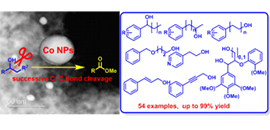 09 18, 2020Cobalt Nanoparticles-based Catalyst to Break Successive C-C Bonds in Alcohols to Form EstersScientists from DICP developed cobalt nanoparticles-catalyzed widely applicable successive C-C bond cleavage in alcohols to access esters.
09 18, 2020Cobalt Nanoparticles-based Catalyst to Break Successive C-C Bonds in Alcohols to Form EstersScientists from DICP developed cobalt nanoparticles-catalyzed widely applicable successive C-C bond cleavage in alcohols to access esters.
Carbon-carbon (C-C) bonds are fundamental building blocks that make up organic compounds. Selective cleavage and functionalization of C-C bonds are important in organic chemistry, biodegradation, and oil industry.
However, functionalization of C-C bonds by controlled cleavage remains difficult and challenging because they are inert.
Recently, a research group led by Prof. DAI Wen from the Dalian Institute of Chemical Physics of the Chinese Academy of Sciences developed heterogeneous cobalt nanoparticles catalyst with dioxygen as the oxidant to break successive C-C bonds in alcohols to form esters with one or multiple carbon atoms less.
Scientists develop cobalt nanoparticles-catalyzed widely applicable successive C-C bond cleavage in alcohols to access esters (Image by LUO Huihui)
They prepared heterogeneous Co-NC catalysts for the aerobic oxidative successive C-C bond cleavage of various functionality aromatic, aliphatic, heterocyclic, allylic, propargylic primary and secondary alcohols to one or multiple carbon atoms shorter esters with O2 as the oxidant. The catalyst was used for seven times without any decrease in activity.
Characterization and control experiments disclosed that cobalt nanoparticles were responsible for the successive cleavage of C-C bonds to achieve excellent catalytic activity, while the presence of Co-Nx had just the opposite effect.
Preliminary mechanistic studies revealed that a sequence reaction including stepwise oxidation/nucleophilic addition/C-C bond cleavage was involved in this process.
This work not only realizes successive cleavage adjacent -(C-C)n- bonds, but also provides a new practical method for directly accessing ester through C-C bond cleavage in alcohols.
The study, published in Angew. chem. int. Ed. on August 24, was supported by National Natural Science Foundation of China. (Text by LUO Huihui) -
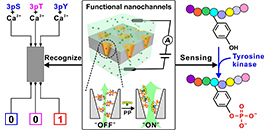 09 17, 2020Functional Ion Nanochannel-based Approach to Detect Tyrosine PhosphorylationScientists from DICP developed a new approach based on a functional ion nanochannel platform, and achieved the specific sensing of tyrosine phosphorylation.
09 17, 2020Functional Ion Nanochannel-based Approach to Detect Tyrosine PhosphorylationScientists from DICP developed a new approach based on a functional ion nanochannel platform, and achieved the specific sensing of tyrosine phosphorylation.
Tyrosine phosphorylation (pTyr) can initiate cellular signaling and govern cellular functions. Its dysregulation is implicated in many diseases, especially cancers. Specific detection of pTyr is important for developing targeted anti-cancer drugs.
The commonly-used approach for detecting pTyr relies on the radiometric assay with [γ-32P]-ATP as a substrate, which suffers from the use of harmful radioactive reagent and generation of radioactive waste.
Antibody-based methods and some synthetic chemical sensors have also been developed to achieve specific detection of pTyr for kinase inhibitor screening assays. However, these methods are not cost-effective.
Recently, a research group led by Prof. QING Guangyan from the Dalian Institute of Chemical Physics (DICP) of the Chinese Academy of Sciences developed a new approach based on a functional ion nanochannel platform for the specific sensing of tyrosine phosphorylation.
The results were published in J. Am. Chem. Soc. on Sept. 7.
Functional nanochannels for sensing tyrosine phosphorylation (Image by QING Guangyan)
By mimicking the multiple interactions of guanidinium groups from arginine residues with phosphorylated residue in proteins, the researchers designed a functional polymer bearing rich guanidinium groups to modify an ion nanochannel substrate, and developed a functional nanochannel device.
The polymer could recognize the phosphorylated peptide (PP) through the binding of guanidinium group with phosphate group in PP, and amplify such recognition to the conformational change of the polymer itself. Further, the conformational change was converted into the "OFF-ON" change of nanochannel ion flux, finally achieving the detection of PP by means of the change in ionic current.
The specific recognition for pTyr peptide from its counterparts pSer and pThr peptides was achieved by constructing a simple nanofluidic logic gate when Ca2+ was introduced as a competitive binding element.
Importantly, the excellent pTyr sensing capacity makes the functional nanochannels available for real-time monitoring of pTyr process by tyrosine kinase on a peptide substrate, even in a complicated condition, and the proof-of-concept study of monitoring kinase activity demonstrates its potential in kinase inhibitor screening.
This work was supported by the National Natural Science Foundation of China, DICP Innovation Funding and LiaoNing Revitalization Talents Program. (Text by QING Guangyan) -
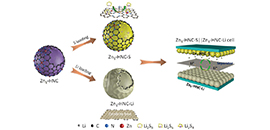 09 15, 2020Researchers Develop Novel Dual-functional Nanoreactors for Lithium Sulfur Full BatteriesScientists from DICP developed single atom zinc (Zn) decorated hollow carbon spheres as dual‐functional nanoreactors for polysulfides‐suppressed sulfur cathodes and dendrite‐free lithium anodes simultaneously for high‐capacity, high‐rate, and long‐cycling Li–S batteries.
09 15, 2020Researchers Develop Novel Dual-functional Nanoreactors for Lithium Sulfur Full BatteriesScientists from DICP developed single atom zinc (Zn) decorated hollow carbon spheres as dual‐functional nanoreactors for polysulfides‐suppressed sulfur cathodes and dendrite‐free lithium anodes simultaneously for high‐capacity, high‐rate, and long‐cycling Li–S batteries.
The lithium sulfur (Li-S) battery with high energy density and capacity is a preferential option for next‐generation energy storage technologies. However, the lithium polysulfide shuttling, sluggish redox kinetics, and uncontrollable lithium dendrite growth resulted in low capacity, and limited cycling stability.
Research groups led by Prof. WU Zhongshuai and Prof. YANG Qihua from the Dalian Institute of Chemical Physics of the Chinese Academy of Sciences developed single atom zinc (Zn) decorated hollow carbon spheres as dual‐functional nanoreactors for polysulfides‐suppressed sulfur cathodes and dendrite‐free lithium anodes simultaneously for high-capacity, high-rate, and long-cycling Li-S batteries.
This work was published in Advanced Energy Materials on August 30.
The nanoreactor could host the polysulfides-suppressed sulfur cathode and the dendrite-free lithium anode simultaneously for kinetically enhanced, extremely stable, and high-rate Li-S full batteries.
Due to its excellent electronic conductivity, high surface area, highly-effective active sites and protective carbon shell, the resultant nanoreactor possessed strong physical confinement, chemical anchoring, and exceptional electrocatalysis for polysulfides. Meanwhile, the nanoreactor with excellent lithiophilic ability realized uniform and dendrite-free lithium deposition.
The assembled full battery delivered remarkable electrochemical properties including long cycle stability with an ultralow capacity fading rate of 0.015% per cycle over 700 cycles and superb rate performance of 989 mAh/g at 10 C. Moreover, a high areal capacity of 8.7 mAh/cm2 with high S loading of 7.8 mg/cm2 at low E/S ratio was achieved.
Synthesis schematic of the dual‐functional Zn1‐HNC nanoreactors for Zn1‐HNC‐S cathode and the Zn1‐HNC‐Li anode of the Zn1‐HNC‐S||Zn1‐HNC‐Li full battery (Image by SHI Haodong and REN Xiaomin)
This work was supported by the National Natural Science Foundation of China, National Key R&D Program of China, and Dalian National Laboratory For Clean Energy. (Text by SHI Haodong and REN Xiaomin)